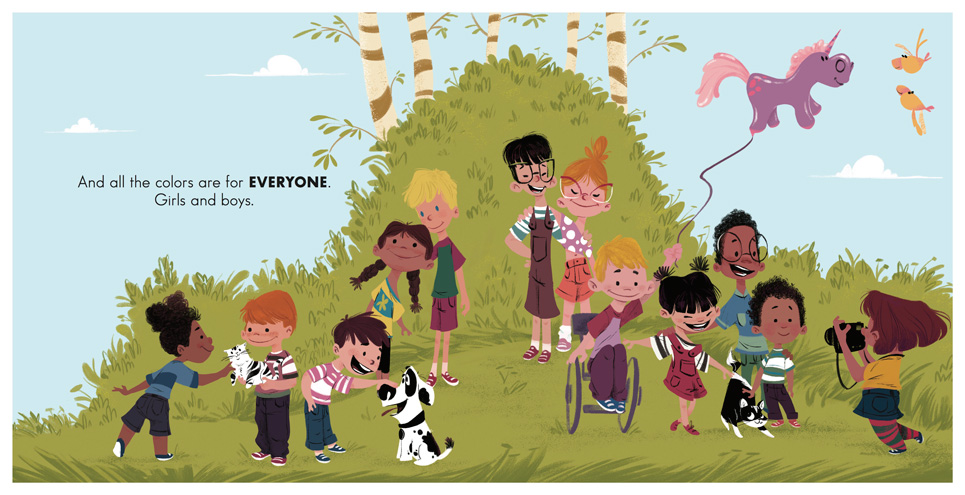Growing Readers: Learning to Love Reading and Writing Column 37
Gender stereotypes, on the surface, may seem like a trivial issue, but it’s not just a case of too much pink and blue. If we impose rigid ideas of masculinity and femininity on children, we limit their potential and actually cause real harm in later life.
Eva Pemberton
Eva Pemberton from the City of Birmingham School of Education and Social Work wrote an eye-opening article about the negative impacts of gender stereotyping on young children later in life. Despite society’s greater openness in this regard, there is still much work to be done to inspire our kids to be exactly who they want to be.
It’s difficult to say which gender stereotype can cause the most problems—for example, encouraging boys to hide their feelings and stay “tough” has had devastating effects throughout history. On the other hand, with girls, evidence shows that their self-esteem plummets when they hit puberty. Our children’s job is to feel their feelings and as their caregivers, parents need to help provide them with the tools to help them manage and work with these feelings. Dr. Becky Kennedy, a clinical psychologist, mother of three, and founder of Good Inside and a parenting podcast, does a great job teaching parents this critical message.

The following book recommendations are wonderful discussion starters. The impact inspiring and powerful books have on young kids cannot be overstated. Let’s do what we can to lift every child up as much as possible so that they are better equipped to stay true to who they are and feel comfortable and confident in how they grow and change as people, too.
The Kids’ Booklist that Smashes Gender Stereotypes
Read About It
Pink is For Boys
Written by Robb Pearlman and Illustrated by Eda Kaban
Buy the Book
Except When They Don’t
Written by Laura Gehl and Illustrated Joshua Heinsz
Buy the Book
Julián is a Mermaid
Written and Illustrated by Jessica Love
Buy the Book
Rainbow Boy
Written by Taylor Rouanzion and Illustrated by Stacey Chomiak
Buy the Book
Strong
Written by Rob Kearney and Eric Rosswood and Illustrated by Nidhi Chanani
Buy the Book
John’s Turn
Written by Mac Barnett and Illustrated by Kate Berube
Buy the Book
Oliver Button is a Sissy
Written and Illustrated Tommie dePaola
Buy the Book
Dogs Don’t Do Ballet
Written by Anna Kemo and Illustrated by Sarah Ogilvie
Buy the Book
My Princess Boy
Written by Cheryl Kilodavis and Illustrated by Suzanne DeSimone
Buy the Book
Tough Guys Have Feelings Too
Written and Illustrated by Keith Negley
Buy the Book
Today I Feel
Written and Illustrated by Madalena Moniz
Buy the Book
Mae Among The Stars
Written by Roda Ahmed and Illustrated by Stasia Burrington
Buy the Book
William’s Doll
Written by Charlotte Zolotow and Illustrated by William Pene du Bois
Buy the Book
Hair Twins
Written by Raakhee Mirchandani and Holly Hatam
Buy the Book
Not all Princesses Dress in Pink
Written by Jane Yolen and Heidi E. Y. Stemple
Buy the Book
Buy the Book
The Best Man
Written by Richard Peck
Buy the Book
This is your Brain on Stereotypes: How Science is Tackling Unconscious Bias
Written by Tanya Lloyd Kyi and Illustrated Drew Shannon
Buy the Book
Extension Activities
Chat About It
Discuss gender stereotypes openly and freely with your kids. Simply put, stereotypes are things people believe to be true about a particular group that are SOMETIMES true, but are NOT always true. Keep having these conversations with your kids. Talk to them when you notice gender stereotypes in real life; learn and explore together. Doing this will help your kids become more aware of things or people who want your child to fit into a particular box and teach them to recognize and spend time with things and people who encourage them to be who they are.
If you’re looking for non-fiction books that specifically discuss the topic of gender identity in a kid-friendly way, here’s our list of the best books about gender identity for kids.
Create Art About it
Once your kids have explored the idea of gender stereotypes a bit more, encourage them to express their thoughts and feelings through any form of art. Whatever feels best for your child to express themselves, whether it be a mural, collage, painting, doodle, poem, song, or comic, there is no right or wrong way to try this extension activity. Help them get inspired by browsing books to find something particularly and personally inspiring.
Thank you for reading the Growing Readers: Learning to Love Reading and Writing column. Bookmark this Growing Readers Column link or subscribe to our e-newsletter so you do not miss out on the monthly reading tips. 14 Powerful Books and Tips to Smash Gender Stereotypes was written by Lizzie Mussoline, M. Ed.—follow her on Instagram: @wildflower_learning_denver.